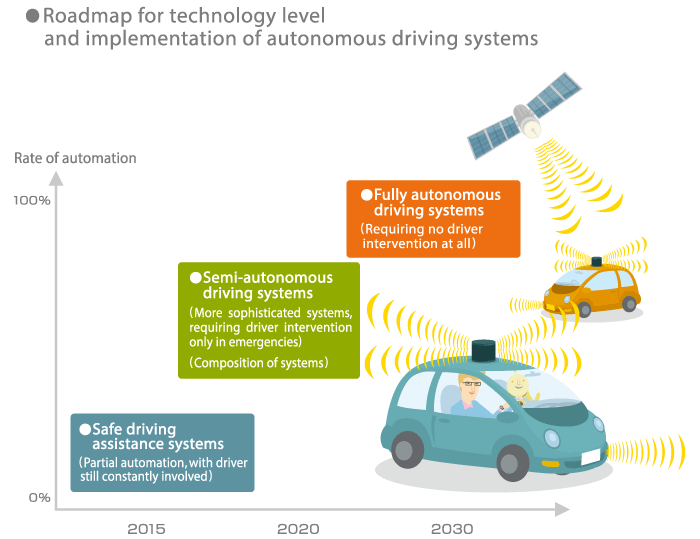Knowledge Box
Vol. 1 Battery Solutions for Wearable Devices
Energy Harvesting (EH), also called power harvesting is a technology aimed at creating battery-less devices by collecting energy from ambient external sources such as heat, light, vibrations, radio waves etc. It is particularly promising in areas of high affinity such as wearable devices and wireless sensor networks (WSN), and various applications are expected for the near future.
Solving the battery problem is crucial for wearable devices
Wearable devices in a variety of formats including watches, wrist bands, and eyeglasses are being intensively developed, and 2015 will probably mark the beginning of a more widespread acceptance of such products. They are sometimes also described as "post smartphone ICT equipment," but rather than replacing smartphones, the devices more likely will serve as miniaturized terminals carried by users along with a smartphone. They are also expected to be used for operating computers and peripheral equipment as well as smart TVs and other suitably enabled appliances in the home. By incorporating various sensors, they can be made to wirelessly transmit vital signs such as heart rate and blood pressure of the wearer to a smartphone, serving for health management, health care, and other medical purposes.
Wireless technology is used for communicating with a smartphone. The ultra low power consumption BLE (Bluetooth Low Energy) subset of the Bluetooth standard, added from version 4.0, can help to prolong battery life. Devices incorporating it are denoted as "Bluetooth Smart," and hubs such as smartphones and tablets that support it are called "Bluetooth Smart Ready."
Wearable devices in the form of a personal accessory such as a ring or a pendant are also under development. In future, we may even see household goods, kitchen supplies, stationery and other objects being equipped with wireless communication tags and sensors, and connected to each other in an "Internet of Things" (IoT). But there is still a major technological hurdle that needs to be overcome: the battery problem. Even wearable devices using the ultra low power BLE standard currently still have to be recharged frequently.
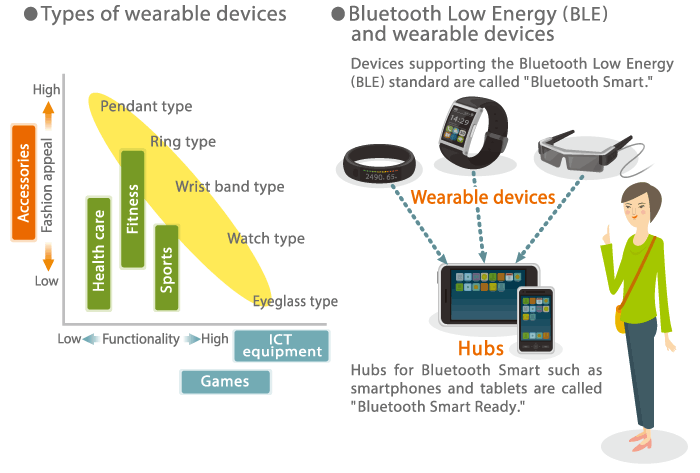
A radical change: electronic devices without batteries
An intriguing possible solution to the battery problem in wearables and wireless sensor networks (WSN) is currently attracting a lot of interest, namely the energy harvesting (EH) approach, also known as power harvesting. This refers to new technologies that harvest (i.e. collect) energy from external sources such as heat, light, vibrations, radio waves etc. and turn it into electrical energy.
In a way, energy harvesting is an old as well as a new approach. The crystal radios common at the beginning of the 20th century derived energy from the captured radio waves to drive an earphone. They were battery-less radio receivers. Solar powered calculators and watches also are energy harvesting devices making use of film type solar cells. In recent years, energy harvesting technologies are again drawing attention. This is because low power IC chips and other components have now been developed that increase the feasibility of using harvested energy as an auxiliary power source for mobile devices and making it possible to realize battery-less sensor modules and similar.
Unlike renewable energy sources such as solar or wind power installations, energy harvesting only produces very low power levels on the order of several microwatts (10-6W) to milliwatts (10-3W). However, sources for this kind of energy are all around us. When used in combination with suitable sensing technology and wireless technology, it becomes possible to configure sensor network systems that do not require battery replacement or charging. For example, the use of human detection sensors enables automatic control of lighting as well as heating/cooling, which is a key element of energy management systems for smart buildings or smart houses. Applications in extreme environments where regular power supplies are not feasible or where humans cannot go are also a promising field.
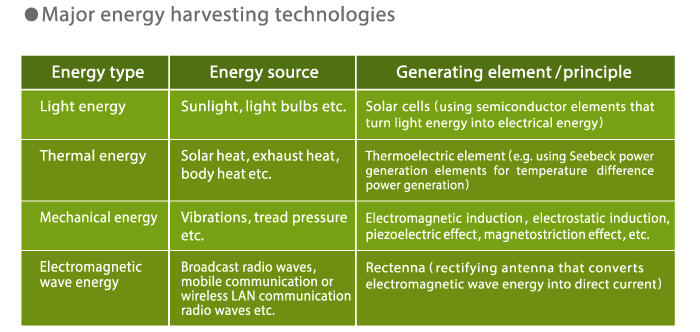
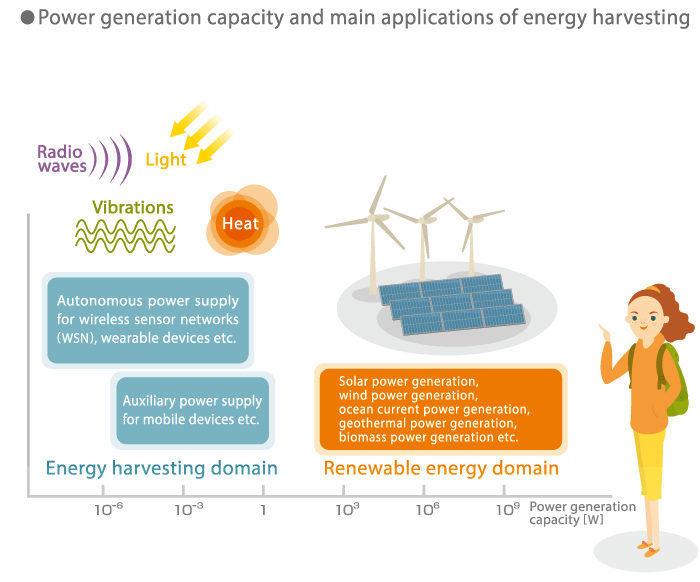
Wireless sensor modules for wireless sensor networks
An example for the circuit configuration of a battery-less wireless sensor module using energy harvesting is shown below. The module uses a harvester for collecting thermal or vibration energy etc. from the environment, which is turned into electrical power. Different kinds of harvesters are possible, including Seebeck elements that convert thermal energy into electricity, and piezoelectric elements that convert pressure into electricity (either piezoelectric ignition elements making use of the piezoelectric effect or piezoelectric buzzers and piezoelectric actuators utilizing the reverse piezoelectric effect). However, as the energy derived from the environment is not constant, a power control circuit serves to either step up or step down and stabilize the power, and electric double layer capacitors (EDLC) or lithium ion polymer cells etc. are used for storage. Environment information obtained from various sensors such as an atmospheric pressure sensor and temperature sensor is processed by a microprocessor and then transmitted via the wireless transceiver and antenna.
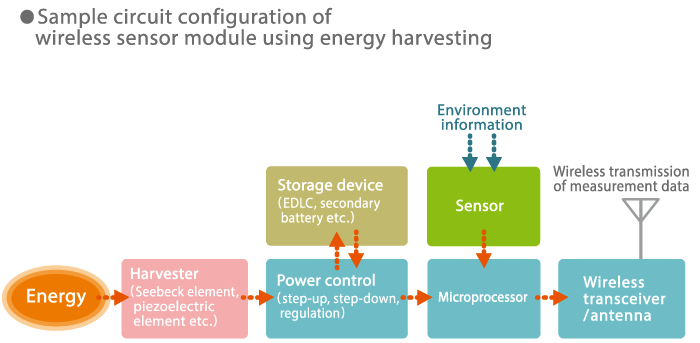
TDK's SESUB technology enables extremely compact high-performance modules
Wireless sensor modules, wearable devices and similar not only need to be highly efficient, they also must be made as small as possible. However, with conventional methods, there are limits to miniaturization that are hard to overcome. In view of this fact, a new technology is currently drawing significant interest. Rather than mounting electronic components on a board or substrate such as usually done, it involves embedding them into the substrate itself. TDK is already offering a range of extremely compact modules based on its proprietary SESUB (Semiconductor Embedded in SUBstrate) technology, which is highly suited for wearable devices and energy harvesting applications etc. Integrated circuit chips (bare chips) whose profile has been lowered by grinding are directly embedded in a multilayer substrate of only 0.3 mm thickness. TDK also has newly developed ultra-thin flexible capacitors (TFCP) for embedding into the substrate.
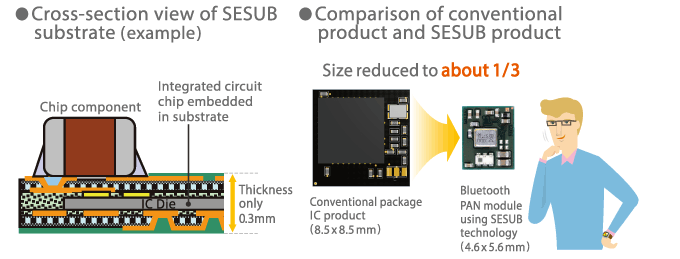
Wearable devices and energy harvesting devices represent a new field in the domain of electronics, realized through the integration of a wide range of cutting-edge elemental technologies. TDK's core technologies based on a deep understanding of materials technology are making highly significant contributions in a variety of ways. Starting from multilayer ceramic chip capacitors and other miniaturized electronic components, this also includes thin film devices made possible by applying manufacturing techniques from HDD heads, as well as MEMS pressure sensors and other sensors using Micro Electro Mechanical Systems technology. Furthermore, power electronics technology as exemplified by compact, high-efficiency DC-DC converters, and wireless power transfer systems utilizing high-performance ferrite materialsare also helping to drive progress in this area.
TDK is a comprehensive electronic components manufacturer leading the world in magnetic technology



